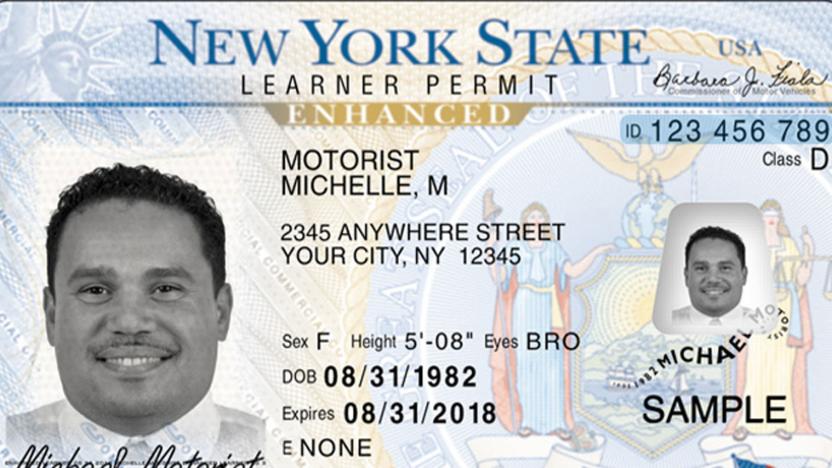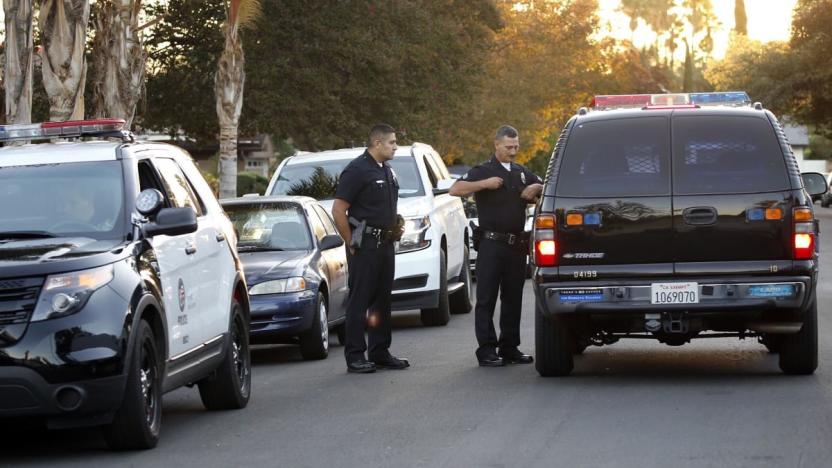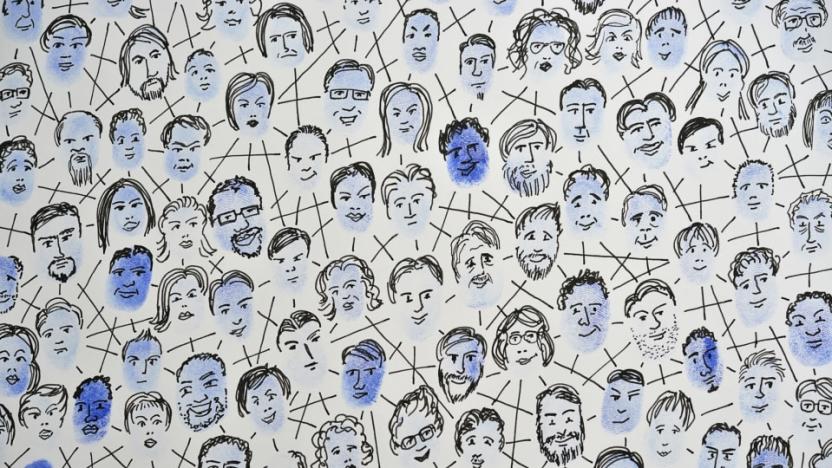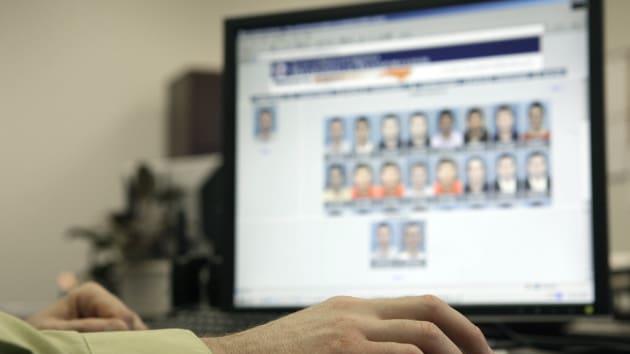facerecognition
Latest

New York's smarter face recognition catches more ID thieves
Sometimes, behind-the-scenes tech upgrades can make a big difference. New York's Governor Cuomo reports that an overhaul of the state DMV's face recognition software in January has led to more than 100 arrests and 900 open investigations so far. The trick? The new system checks 128 points on a face instead of 64, dramatically increasing the chances that it'll match a photo against the DMV's database. Combine that with new comparison modes (like black-and-white and overlays) and it's easier to catch identity thieves and fraudsters, such as one man who tried to get a license with a stolen identity in order to evade a suspension.

These are the first third-party Windows Hello cameras
Microsoft's Windows 10 computers have a log in feature called Windows Hello, where users are able to access their devices using facial recognition algorithms. On the downside, the feature was only available on newer devices with depth-sensing cameras built-in. That is, until eye-tracking company Tobii decided to change things up by offering support for the service with its standalone cameras.

Computers learn how to spot hidden facial expressions
Machines are good at spotting obvious emotions like smiles, but they're not so hot at detecting the extremely brief microexpressions that reveal when people are covering up their true feelings. They may have a keener eye in the future, though: researchers have developed a computer vision algorithm that magnifies facial expressions, making it possible to catch the tiniest bit of displeasure or surprise. While some humans have a knack for spotting these subtle cues, the algorithm is far more effective in early tests -- you likely wouldn't fool the computer into thinking everything was hunky dory.

California police use these biometric scanners
Police are increasingly turning to biometric tech in the field. It's supposed to help cops verify the identity of suspects, but there's a real concern that they could abuse this to get personal details on record -- and the Electronic Frontier Foundation wants you to know when this hardware might come into play. The rights group has published a report detailing the biometric scanners in use by California law enforcement, and they're in more widespread use than you might think. Mobile fingerprint readers are in use at several departments, and face recognition is getting traction. The Los Angeles County Sheriff's Department is using tattoo recognition, and some police departments are looking into iris scanning.

OMRON's Family Eye home camera is both cute and powerful
Most home security cameras these days already come with microSD storage, two-way audio, motion detection and night vision, so it's about time someone offers a more powerful package. If you happen to reside in Japan, then you may want to consider OMRON's Kazoku Mesen aka Family Eye. Hardware-wise this is just a cute 720p video camera with all of the aforementioned features, but it's the company's OKAO Vision technology that really sells it: It's able to recognize faces, hand gesture, age, gender, expressions (it can automatically take photos of a baby whenever he or she smiles) and even cats plus dogs. Offices and shops can also take advantage of the Family Eye for customer analysis and head counts. Not bad for a ¥29,800 (about $250) kit, except for one slightly unfortunate flaw: It cannot record video, just still photos, so you'll have to rely on notifications and the app's live stream feature. We still want one, anyway.

I had to smile for my free cup of coffee at a trade show
#fivemin-widget-blogsmith-image-601847{display:none;} .cke_show_borders #fivemin-widget-blogsmith-image-601847, #postcontentcontainer #fivemin-widget-blogsmith-image-601847{width:629px;display:block;} try{document.getElementById("fivemin-widget-blogsmith-image-601847").style.display="none";}catch(e){} Coffee, pens, non-existent free WiFi, and USB sticks are the four spirit animals of any tech show. But what if a company wants you to be happy before you've got your cup of morning sunshine? That's DigitalSTROM's gambit, using its sensors and Intel's RealSense 3D camera to detect when you're smiling before delivering your daily caffeine hit. Sensing a grimace could prove more practical.

Windows 10's face detection isn't easily fooled by twins
Windows 10's facial recognition is supposed to make it easy to sign into your PC while maintaining security, but just how good is it? Good enough that even your doppelganger might not get in, apparently. The Australian has conducted an informal test where it tried to fool Windows using sets of identical twins, and the software wasn't tricked once -- it had a problem logging in both twins in one instance, but it otherwise allowed only those individuals that had set up recognition in the first place. That was true even when the 'evil' twins attempted to spoof the camera by adjusting their hair or removing their glasses.

Face-tracking tech knows when you skip church services
More than two dozen churches around the world have installed a facial-recognition system that monitors which members of the flock have actually shown up for the Sunday sermon. The system is called Churchix and was developed by Israeli software company, Face-six. It continually scans the religious center's CCTV feed and matches congregation members to a pre-existing database of their faces -- reportedly with 99 percent accuracy.

Police face-scanned 90,000 people at Download music festival
Unbeknownst to Download attendees, Leicestershire Police were using facial recognition software last weekend to identify known crooks. Roughly 90,000 people descended on the music festival, and strategically placed cameras were used to scan their faces and cross-reference them with a European database. Privacy advocates weren't best pleased when Police Oracle first revealed the police's plans, and now the force has come forward to defend its actions. It says the cameras didn't take or store anyone's photograph, and that the software only compared faces against a list of people known to commit crimes at festivals. In addition, all of the data was destroyed at the end of the weekend.

Students design a facial recognition cane for blind people
Facial recognition technology has many use cases, but none nearly as significant as this next one might be. A group of students at Birmingham City University are developing a smart cane, dubbed XploR, which uses a combination of hardware and software to help the visually impaired easily identity family and friends. The device is powered by a smartphone's face recognition features, GPS and Bluetooth, allowing blind people who use it to detect faces up to roughly 33ft away. If the cane does recognize someone, it then sends a vibrating signal to the person and guides them via an ear piece -- for reference, the images of loved ones can be stored on an SD card.

DC airport tries using face recognition to catch imposters
If you come to the US through Washington DC's Dulles airport in the near future, don't be surprised if Customs and Border Protection takes your snapshot before letting you through. The agency has confirmed to Motherboard that it will be testing a facial recognition system which captures a photo and compares it against your passport picture to see if you're an imposter. The relatively short (2 to 3 months) trial won't rely solely on face detection to flag suspicious travelers, but it could give customs agents a way to double-check identities without relying so heavily on keen eyes and intuition.

Facebook said to bring back some face-recognition features in the EU
In the past, European data authorities haven't been very receptive of Facebook's facial-recognition software. But it looks like that might be changing soon. According to TechCrunch, the social networking titan has (quietly) started to restore some face-recognition services in Europe, though there are a few compromises to consider. What this means is that Facebook users across the pond are once again seeing the "tag suggest" option within pictures they have uploaded, but it can only be used on friends who are in the US and have the tagging feature enabled on their accounts. Perhaps, Facebook's finally managed to address the concerns Euro officials had with its savvy tech, and that could be why the changes have taken place. With nothing confirmed, however, we reached out to Facebook for comment and will update this story if we hear back.

The NSA has collected 'millions' of faces from the web
The NSA isn't just interested in pure communications intelligence like call records; it wants to look for faces, too. Documents leaked by Edward Snowden reveal that the NSA has been using facial recognition software to scan the internet for portraits and match them with investigative data. The agency can determine whether or not a suspect spotted in a photo or video chat has a valid passport, for example, or find out if informants have said anything about that person. It can even spot subtle changes (like beards) and link photos to satellite info to pinpoint someone's whereabouts. As of 2011, the NSA was getting about 55,000 "facial recognition quality" images per day out of "millions" of candidates, according to the leaked material.

Facebook's face-recognition tech is almost as good at Stallone-spotting as you are
Facebook's long been interested in facial recognition, as the photo tag-suggestion feature that didn't go down too well in Europe shows. The Zuck's social network also gobbled up a face-recognition outfit in 2012, but it's Facebook's AI research team that's made headway recently with technology that's almost as good as us meatsacks at identifying mugs. Known as DeepFace, the system uses a "nine-layer deep neural network" that's been taught to pick up on patterns by looking at over 4 million photos of more than 4,000 people. We're not as up-to-date with complex machine learning techniques as we should be, either, but the main reason DeepFace is so accurate is its method of "frontalization" -- or, creating a front-facing portrait from a more dynamic source image.

Apple applies for patent that scales content to match face distance, save us from squinting
Most software has to be designed around a presumed viewing distance, whether it's up close for a smartphone or the 10-foot interface of a home theater hub. Apple has been imagining a day when the exact distance could be irrelevant: it's applying for a patent that would automatically resize any content based on viewing distance. By using a camera, infrared or other sensors to detect face proximity through facial recognition or pure range, the technique could dynamically resize a map or website to keep it legible at varying ranges. Although the trick could work with most any device, the company sees that flexibility as most relevant for a tablet, and it's easy to understand why -- iPad owners could read on the couch without needing to manually zoom in as they settle into a more relaxed position. There's no knowing the likelihood that Apple will implement an automatic scaling feature in iOS or OS X, let alone make it the default setting. If the Cupertino team ever goes that far, though, we'll only have our own eyesight to blame if we can't read what's on screen.

Apple files patent application for fingerprint sensor that can be transparent or opaque
While Apple has flirted with biometric-based patents before, we've yet to see them implemented in real-world technology. That hasn't stopped it from filing yet another one though, as the latest application reveals a fingerprint sensor apparently embedded into the iPhone itself. The patent describes a hardware "window" that can become selectively "transparent or opaque." When transparent, it would reveal a component comprised of an "image capture device, a strobe flash, a biometric sensor, a light sensor, a proximity sensor, or a solar panel, or a combination thereof" as a method of unlocking the phone. According to the filing, the biometric sensor in question might indeed be a fingerprint reader. The document goes on to describe an alternative method using face or eye recognition technology that can be used not just for security purposes, but for possible e-commerce solutions like completing an online transaction. Of course, take any of these patent applications with a generous pinch of salt -- we haven't seen an Apple stylus yet, for example -- but perhaps this is the reason Apple bought fingerprint sensor maker AuthenTec back in July.

Googlerola buys Viewdle, ups Android's augmented reality and face recognition game
From existing tech like Face Unlock and Google Goggles to patent filings and Project Glass, it's clear that Google sees augmented reality and image recognition playing a big part in our computing future. It makes sense, then, that Big G subsidiary Motorola has bought Viewdle -- a Silicon Valley company that builds face, object, and gesture recognition technology for mobile devices. We don't know how much MMI paid for Viewdle, but we do know, thanks to a statement obtained by the good folks at TechCrunch, that the two firms "have been collaborating for some time." So, hopefully Android will reap the benefits (and fix those Face Unlock flaws) in the not-so-distant future.

Fujitsu outs Esprimo X all-in-one at IFA 2012: Windows 8, adjustable display, Intel vPro Core CPUs
Fujitsu's keeping its IFA 2012 presence relatively low-key, holding off on any new major tablet or mobile announcements. So while we may have already seen its Windows 8 Stylistic Q702 and LifeBook T902 in Hong Kong last week, there is still one product the company's trotting out here in Berlin: the Esprimo X. Planned for a late year launch, this All-in-one also runs Redmond's latest OS and packs Intel's third-generation vPro chipset (up to Core i5 configurations) for the enterprise set. The slim PC features an adjustable touch display, which can even be laid out completely flat across any surface, a proximity sensor for power saving management, in addition to face recognition tech for an added layer of security. No other details on this AIO have yet to be disclosed -- the company's retaining those fuller spec bits for its release -- so stay tuned for our first impressions from the showfloor.

Sony takes SOEmote live for EverQuest II, lets gamers show their true CG selves (video)
We had a fun time trying Sony's SOEmote expression capture tech at E3; now everyone can try it. As of today, most EverQuest II players with a webcam can map their facial behavior to their virtual personas while they play, whether it's to catch the nuances of conversation or drive home an exaggerated game face. Voice masking also lets RPG fans stay as much in (or out of) character as they'd like. About the only question left for those willing to brave the uncanny valley is when other games will get the SOEmote treatment. Catch our video look after the break if you need a refresher.

YouTube add face blur tech to its videos, creates anonymous copies of your clips
YouTube has added another feature to its enhancements tool, allowing you to automate the process of blurring out people's faces in your photos. Its makers are quick to add that it's still an emerging technology, and that it may still miss out on faces depending on lighting obstructions and video quality. YouTube cites footage from human rights issues for bringing the idea forward, where identification of those involved could prove dangerous. You'll be able to preview how it looks, and if you choose to include the blurred option, a new copy is made to avoid losing the unedited original. The feature is rolling out to the site today -- now you just need a decent video camera.










